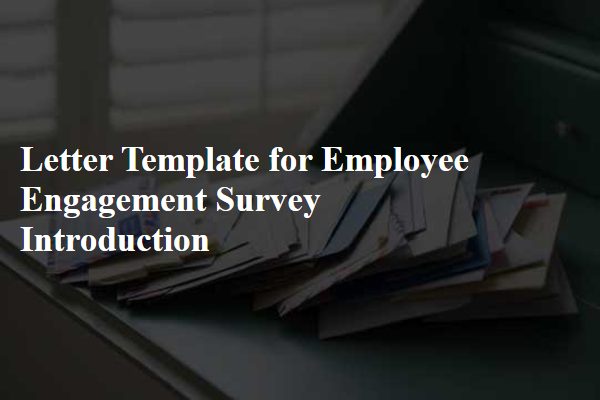Hello Team! We're excited to invite you to participate in our upcoming employee engagement survey, designed to gather your valuable insights and feedback. Your opinions matter greatly, and they will help us create a supportive work environment where everyone can thrive. So, let's dive in together and shape the future of our workplaceâread on to find out more about how you can contribute!

Purpose and Objective
The employee engagement survey serves as a vital tool for assessing the overall satisfaction and commitment levels of staff members within the organization. Designed for all employees across various departments and levels, this survey aims to gather valuable insights regarding workplace culture, communication effectiveness, and professional growth opportunities. Responses will be analyzed to identify trends and areas requiring attention, enabling the organization to implement strategic initiatives that foster a more engaged and motivated workforce. The objective is to create a constructive dialogue aimed at enhancing employee experiences, ultimately boosting retention rates and overall productivity.
Anonymity and Confidentiality
Employee engagement surveys play a vital role in understanding workforce morale and satisfaction within organizations. These surveys, designed to improve job satisfaction and productivity, ensure anonymity and confidentiality, fostering an open environment for honest feedback. Anonymity guarantees that individual responses remain untraceable, allowing employees to express their opinions without fear of repercussions. Confidentiality reinforces this trust, as survey data is aggregated and reported only in a manner that safeguards personal identities. By prioritizing these elements, organizations can obtain valuable insights to drive positive changes in workplace culture and employee experiences, leading to enhanced overall performance.
Survey Duration and Deadline
The employee engagement survey, designed to gather valuable insights regarding workplace satisfaction and overall employee experience, will be available from March 1, 2024, to March 15, 2024. This two-week period allows every employee ample time to participate. The survey aims to assess key factors such as workplace culture, communication effectiveness, and professional development opportunities within the organization. Timely feedback during this engagement initiative will inform future strategies to enhance employee satisfaction and foster a positive work environment. Participation is encouraged to ensure all voices are represented in this crucial evaluation.
Instructions and Participation Process
Employee engagement surveys play a crucial role in understanding workplace dynamics and enhancing employee satisfaction. These surveys, typically conducted via online platforms like SurveyMonkey or Google Forms, provide employees with a chance to voice their opinions regarding various workplace aspects, including management practices, team collaboration, and job satisfaction. Participation is anonymous, encouraging honest feedback. Employees will receive an invitation via company email, outlining survey access and completion instructions. The survey window spans two weeks, ensuring ample time for thoughtful responses. Results will be analyzed and shared with the entire organization, fostering a culture of transparency and continuous improvement.
Contact Information for Queries
Employee engagement surveys play a critical role in assessing workforce sentiment and fostering a collaborative workplace culture. Organizations, such as Fortune 500 companies, actively use these surveys to gauge employee satisfaction, retention, and overall morale. For further inquiries regarding the survey process or feedback mechanisms, employees may connect with the human resources department through designated contact information, including email addresses or phone numbers, ensuring seamless communication. Encouraging participation and addressing concerns promptly enhances the effectiveness of the survey results, ultimately driving organizational improvement initiatives.













Comments